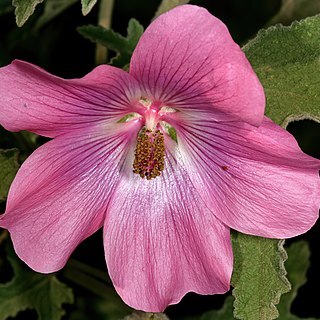Ascending, suffruticose or shrubs, to 1.2(-2.5) m tall; closely to rather loosely stellate-pubescent, the hairs sessile to stalked, the stalks often stellulate, the arms mostly numerous, radiate, fine. Leaf blades mostly thin, more or less bicolored, dark yellow-green or yellow-green above, paler below, up to 15(-20) cm long, varying from oblong-lanceolate and unlobed to about as broad as long and digitately 3-, 5-, or 7-lobed, the terminal lobe much the longest, oblong-ovate to-lanceolate, the lateral lobes usually of similar shape but sometimes greatly reduced in size, the leaf apex obtuse to acute, the base subcuneate to closed-cordate, the margins obscurely to coarsely crenate to dentate, the ventral surface plane or rugulose, usually velvety-pubescent with mostly bifurcated or stellate hairs; petioles stout or slender, 1-10 cm long, mostly one-to two-thirds as long as the blade but sometimes conspicuously shorter in the inflorescence; stipules subulate, mostly 3-9 mm long. Inflorescence racemose to corymbose-cymose, the flowers solitary in the upper leaf axils or several in axillary or more or less terminal, open, naked cymes; pedicels mostly 1-3 cm long, apically jointed. Involucral bracts 3, generally connate marginally at least below and enclosing the calyx in early bud, at anthesis mostly less than two-thirds as long as the calyx, varying from thin, chartaceous, stellate-puberulent, and sometimes early-deciduous, to thick, prominently nerved, coarsely stellate, and bearing digitiform appendages up to 4 mm long, the divisions of the involucre narrowly oblong-lanceolate to broadly ovate, (3-)5-10(-13) mm. long, (0.7-)2-8(-11) mm broad, the apex acute to short-acuminate or mucronate, the margins entire to crisped and irregularly callose-denticulate. Calyx ovate-elliptic, not angled or slightly angled in bud, campanulate at anthesis, densely stellate-pubescent, (7-)9-16(-20) mm long, the lobes (4-)5-10(-13) mm long, 2.5-6.5 mm broad, lanceolate to ovate, apically acute or acuminate, as long or up to 3 times as long as the tube. Petals pinkish to rose-magenta with the veins usually darker at the base, 1.5-3(-4) cm long, 1-2(-2.8) cm broad, obovate, obliquely subemarginate to truncate apically, narrowed with straight sides to a nonauriculate base, glabrous or pubescent at the base both ventrally and dorsally but always setose-ciliate. Staminal column included, 6-10 mm long, pale magenta, glabrous or copiously pubescent from the base to the filaments; filaments up to 2 mm long, arising over the upper two-thirds of the column; anthers 117-140 in an elongate-ellipsoid cluster. Style branches glabrous or white-pubescent, slender but abruptly expanded at the apex and capped by white-papillate, oblique or subdecurrent stigmas. Fruit exceeding the calyx tube, to 13 mm in diam., broadly ovoid, acutely concave apically, black or reddish-black beneath the copious, tawny, stellate pubescence; carpels 14-19, each biovulate, woody, 6-8 mm high, 4-5 mm broad, asymmetrically ovate-reniform, obliquely acute at the apex, the lateral walls smooth above, the lowermost 1 mm or so faintly reticulate but without translucent areolae; midvein strongly developed and retaining the carpel after maturity; endoglossum lacking; mature carpels loculicidally dehiscent in the upper half, indehiscent below. Seeds generally 2 in each carpel, the lower usually larger, up to 2.8 mm long, 1.8 mm broad, brownish-black, puberulent.
More
Shrub, 0.80-2.75 m high; stellate-pubescent. Leaves simple to 3-, 5-or 7-lobed, terminal lobe longest; upper surface dark yellow-green, paler below. Flowers solitary or several in cymes. Epicalyx bracts 3, connate below, enclosing calyx in bud. Calyx campanulate, 5-lobed. Petals pinkish to rose-magenta, veins darker at base. Staminal tube included; filaments in upper 2/3 of column, 2 mm long, anthers 117-140 in clusters. Style branches as many as carpels. Flowering time Dec.-Apr. Fruit a schizocarp, broadly ovoid, acutely concave apically. Mericarps 14-19, woody, dehiscent in upper half. Seeds brownish black, puberulent.


